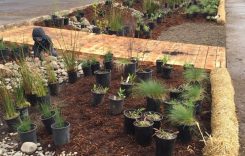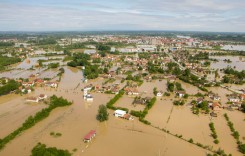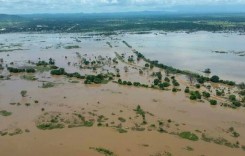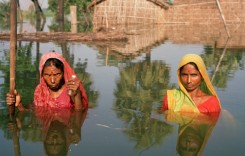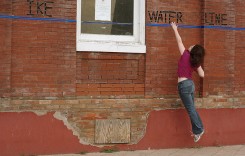Ongoing floods in South Sudan have affected more than 835,000 people across 8 states. Livelihoods, food production and drinking water supply have all been severely impacted. Humanitarian agency Concern Worldwide described the flooding as the worst in 60 years, and estimates over 200,000 people have been forced to leave their homes.

Flooding began with the onset of the rainy season in May this year. In July 7 people died in floods which submerged several homes in Mayendit County. Flooding worsened considerably in the following weeks and by 01 September over 380,000 people across 6 states were affected.
In a recent update, the United Nations said flooding has now affected more than 835,000 people in 33 of South Sudan’s 78 counties. Jonglei, Unity and Upper Niles remain the worst impacted states, with some 80 per cent of the total cumulative number of affected people, the UN said. The situation in particularly bad in Jonglei State, where 305,000 people affected, followed by Unity (220,000 affected) and Upper Nile (141,000 affected).
Flooding has caused severe hardship in affected communities. The UN said, “Homes, nutrition and health facilities, water sources, schools and markets are submerged, impacting people’s access to essential services, eroding their coping mechanisms and exacerbating vulnerability.” People in some affected areas have reportedly no access to safe water, increasing the risk of waterborne diseases.
Thousands of people have been displaced from their homes and moved to higher ground, with many sheltering in churches, schools and public spaces. Floods have also severely impacted livelihoods and food production, destroying farmland, crops and livestock.
“Floodwaters continue to threaten people in areas such as in Bentiu town in Unity State where flood-affected people, including those in the Bentiu displacement camp, are in a dire situation. The floodwaters remain standing and stagnant, with no sign of receding resulting in longer term displacement. In other areas, such as Jonglei and Upper Nile, water continues to rise as water overflowed or broke barriers,” the UN added.
Access to many affected areas is difficult and aid agencies have used boats, trucks and special all terrain amphibious vehicles to reach flooded communities.
According to UN figures, as of the end of November 2021, humanitarian and relief agencies reached 619,000 people with food assistance; almost 477,000 people were provided with emergency water, sanitation and hygiene response; some 227,000 people provided with health services, including out-patient consultations. An estimated 237,000 people received various protection services; some 220,000 people were supported with camp coordination and camp management services; and almost 185,000 people reached with shelter and non-food items. Some 146,000 people were assisted with nutrition support; 181,000 people supported with education in emergency services; and approximately 132,000 people reached with livelihood support.

Worst Floods in 60 Years
Aid and humanitarian agency Concern Worldwide said it has launched an enhanced emergency response in South Sudan after hundreds of thousands of people were forced from their homes by the worst floods in almost 60 years.
“The magnitude of the flooding this year has been immense,” Concern’s Country Director in South Sudan, Shumon Sengupta said. “Over 200,000 people – more than a quarter of the local population in Unity State – have been forced to leave their homes as a result of rising flood waters”.
“There has not been flooding on this scale in the region since 1962, according to local records, and despite agencies like Concern Worldwide working tirelessly to respond to the escalating humanitarian crisis, (with financial assistance of donors such as BHA/USAID, ECHO, GAC, EFP and UNICEF), the needs far exceed the current scale of the humanitarian response, both within and outside the camps for internally displaced people (IDP)”.
“Families have been displaced and are sheltering on higher ground, in public buildings or with neighbours or family. Access to basic services including health and nutrition support has been disrupted as clinics have been damaged, submerged in floodwaters, or are inaccessible.”




Social Media
A thin white line is all that stands between Panyagoor town and the deluge. First picture shows locals building this dyke using used food bags and lots of human effort. Climate change is submerging island states; it’s also drowning landlocked South Sudan. #ClimateAction https://t.co/gAM2DT4EP5 pic.twitter.com/niuLXYDFuQ
— Arafat Jamal (@jhamal4) November 12, 2021
In #SouthSudan, the worst flooding in decades has washed away food, homes & left villages under water. @eu_echo & @UNICEF are helping to treat malnourished children & prevent others from reaching that point. More here w/ photos from #SebastianRich https://t.co/gQVrpdG7CM pic.twitter.com/NHhuvoOQaO
— Mohamed M. M. Fall (@MohamedFall) November 29, 2021
Record floods have displaced thousands of people across #SouthSudan and the situation is extremely difficult in areas like Bentiu, Fangak and Tonj.
Access to flooded areas is challenging but @WFP is supporting almost 500k people with emergency food and nutrition assistance. pic.twitter.com/oCmmjIgVJv
— WFP South Sudan (@WFP_SouthSudan) November 24, 2021

